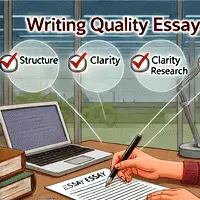 The opening lines of your essay serve as the compass, guiding your reader through the depths of your thoughts and ideas. It is here, in those first few sentences, that you have the power to captivate, intrigue, and assert your professionalism as a writer. But how do you master the art of commencing the essay with finesse, ensuring that your readers are not only enticed but also assured of your expertise? We intend to solve the secrets of crafting an exceptional opening that leaves a lasting impression. The introduction is the gateway and your opportunity to set the stage, establish the tone, and invite your readers to join you on a literary voyage. Whether you are writing an academic essay, a persuasive argument, or a creative piece, the principles of a compelling introduction remain consistent. It is the foundation upon which the rest of your essay will stand, and its construction demands careful consideration. The essay's opening moments offer a variety of techniques to seize the reader's attention as you can pose a thought-provoking question that invites contemplation, share an anecdote that resonates on a personal level, present a startling statistic that evokes curiosity, or introduce a captivating quote that lends authority to your narrative. Each approach possesses its unique allure, designed to draw the reader into the narrative you are about to unfold. A well-crafted introduction goes beyond mere engagement; it communicates your professionalism as a writer. It demonstrates your ability to navigate the waters of language, structure, and rhetoric, while also showcasing your expertise on the chosen topic which serves as a promise to your readers that what follows will be worth their time and attention. As we look deeper into the difficulties of these introduction techniques, you will realize not only how to capture your reader's imagination but also how to affirm your credibility as a writer. Whether you are a seasoned wordsmith or a budding essayist, we are here to equip you with the tools to do your study with confidence, ensuring that your essays begin with a flourish and a lasting impact.
The opening lines of your essay serve as the compass, guiding your reader through the depths of your thoughts and ideas. It is here, in those first few sentences, that you have the power to captivate, intrigue, and assert your professionalism as a writer. But how do you master the art of commencing the essay with finesse, ensuring that your readers are not only enticed but also assured of your expertise? We intend to solve the secrets of crafting an exceptional opening that leaves a lasting impression. The introduction is the gateway and your opportunity to set the stage, establish the tone, and invite your readers to join you on a literary voyage. Whether you are writing an academic essay, a persuasive argument, or a creative piece, the principles of a compelling introduction remain consistent. It is the foundation upon which the rest of your essay will stand, and its construction demands careful consideration. The essay's opening moments offer a variety of techniques to seize the reader's attention as you can pose a thought-provoking question that invites contemplation, share an anecdote that resonates on a personal level, present a startling statistic that evokes curiosity, or introduce a captivating quote that lends authority to your narrative. Each approach possesses its unique allure, designed to draw the reader into the narrative you are about to unfold. A well-crafted introduction goes beyond mere engagement; it communicates your professionalism as a writer. It demonstrates your ability to navigate the waters of language, structure, and rhetoric, while also showcasing your expertise on the chosen topic which serves as a promise to your readers that what follows will be worth their time and attention. As we look deeper into the difficulties of these introduction techniques, you will realize not only how to capture your reader's imagination but also how to affirm your credibility as a writer. Whether you are a seasoned wordsmith or a budding essayist, we are here to equip you with the tools to do your study with confidence, ensuring that your essays begin with a flourish and a lasting impact.
How should you start writing your essay to show professionalism?
- Pose a Thought-Provoking Question: Begin your essay by posing a query that sparks curiosity and encourages critical thinking. For instance, if you're writing an essay on climate change, you might ask, "What will our world look like if we continue to ignore the signs of environmental deterioration?" This not only engages your reader but also establishes the relevance of your topic.
- Share an Intriguing Anecdote: They have the power to humanize your writing and draw readers into your essay which is why we consider starting with a short, relatable story that exemplifies the theme of your essay. If your essay is about perseverance, you could share the story of an individual who overcame significant obstacles to achieve their goals. Personal narratives connect with readers on an emotional level and demonstrate the knowledge of how to start an essay as well as your ability to craft a compelling narrative.
- Provide a Surprising Statistic: This can be shocking, eye-opening, and persuasive, and incorporating a surprising statistic into your essay's introduction can immediately grab your reader's attention. For example, if you're writing about the impact of social media on mental health, you might start with a statistic like, "According to recent studies, the average person spends over two hours a day on social media platforms, contributing to rising rates of anxiety and depression" setting the stage for your essay's exploration of the topic.
- Introduce a Captivating Quote: A well-chosen quote can add depth and authority to your essay's introduction hence the need to select a quote that relates to your topic and resonates with your intended audience. In case your essay is about the power of education, you could begin with Nelson's famous words, "Education is the most effective weapon which you can use to transform the world" which immediately establishes the importance of your subject matter and positions you as a writer who draws inspiration from influential figures.
- Create a Strong Thesis Statement: Your thesis should succinctly convey the main argument or purpose of your essay. For instance, if it is about the benefits of exercise, your thesis could be, "Regular workout not only improves physical health but also enhances mental well-being and overall quality of life."
- raft a Smooth Transition: Ensure that your introduction smoothly leads into the body of your essay as your transition should provide a logical connection between your introduction and the first paragraph of your essay which helps maintain the flow of your writing and keeps your reader engaged.
The art of forming an essay is a skill that our proficient essay writers have mastered with practice and creativity. Your essay's introduction serves as the gateway to the rest of your work, setting the stage for the ideas and arguments that follow. Whether you choose to pose a thought-provoking question, share a compelling anecdote, present a surprising statistic, or introduce a captivating quote, your primary goal is to engage your reader's attention and establish your professionalism as a scholar. Your introduction should not only pique curiosity but also provide a clear sense of direction for your essay. It is where you lay the foundation for your thesis statement and provide a glimpse of the roadmap that will guide your reader through your essay's content. Crafting a strong introduction is a dynamic process that may require multiple revisions, but with dedication and a firm grasp of your subject matter, you can begin your essays with confidence, leaving a lasting impression on your audience.
Help with Starting an Essay | Competent Writers You Can Trust
 Every essay is a process, a look into new ideas, arguments, and narratives. And just like any process, the beginning is of critical importance. It's that initial step onto the path that determines the course of the entire expedition. In academic and creative writing, this first step is encapsulated in the opening sentence of your essay; a sentence that holds the power to captivate, persuade, and inspire. In the ideology of essay writing, the opening sentence is the anchor; the point of departure that propels both the writer and the reader into the core of the narrative. It is the literary equivalent of a captivating sunset that pushes travelers to venture further into the unknown. But what is it about this initial sentence that makes it so crucial? Why does it wield such influence over the entire essay? The answer lies in its multifaceted role. The opening sentence serves as an introduction, a roadmap, and a promise. It introduces the topic, providing readers with a glimpse of what lies ahead. It lays out the path, indicating the direction in which the essay will progress. It makes a promise to the reader; that the journey they're taking will be worth their time and attention. The opening sentence is the first impression, the firm handshake, and the welcoming smile of a well-written school essay. It sets the tone, the mood, and the expectations. It has the power to evoke curiosity, to arouse emotions, and to ignite the intellectual spark. It is your chance to make a statement, to engage your audience, and to establish your authority as an author. Our aim is to look into the art and science of preparing a remarkable opening sentence for your essay as well as explore the various elements that make it great and catchy, dissect its significance, and reveal the secrets to its success. Whether you're a seasoned writer looking to refine your skills or a novice seeking guidance, here, you'll have a deeper understanding of the profound impact a well-crafted opening sentence can have on your writing and your readers.
Every essay is a process, a look into new ideas, arguments, and narratives. And just like any process, the beginning is of critical importance. It's that initial step onto the path that determines the course of the entire expedition. In academic and creative writing, this first step is encapsulated in the opening sentence of your essay; a sentence that holds the power to captivate, persuade, and inspire. In the ideology of essay writing, the opening sentence is the anchor; the point of departure that propels both the writer and the reader into the core of the narrative. It is the literary equivalent of a captivating sunset that pushes travelers to venture further into the unknown. But what is it about this initial sentence that makes it so crucial? Why does it wield such influence over the entire essay? The answer lies in its multifaceted role. The opening sentence serves as an introduction, a roadmap, and a promise. It introduces the topic, providing readers with a glimpse of what lies ahead. It lays out the path, indicating the direction in which the essay will progress. It makes a promise to the reader; that the journey they're taking will be worth their time and attention. The opening sentence is the first impression, the firm handshake, and the welcoming smile of a well-written school essay. It sets the tone, the mood, and the expectations. It has the power to evoke curiosity, to arouse emotions, and to ignite the intellectual spark. It is your chance to make a statement, to engage your audience, and to establish your authority as an author. Our aim is to look into the art and science of preparing a remarkable opening sentence for your essay as well as explore the various elements that make it great and catchy, dissect its significance, and reveal the secrets to its success. Whether you're a seasoned writer looking to refine your skills or a novice seeking guidance, here, you'll have a deeper understanding of the profound impact a well-crafted opening sentence can have on your writing and your readers.
Why is it crucial to use a great & catchy opening sentence when starting your essay?
- Captures the reader's attention: Your opening sentence serves as the first impression your essay makes on the reader which is your opportunity to grab their attention and pique their interest. It can entice the reader to continue and engage with your essay, while a lackluster one may cause them to lose interest before they've even started.
- Sets the tone: Depending on whether it's serious, humorous, or thought-provoking, the reader will have certain expectations about the content that follows as it can provide clarity and context, ensuring that your readers are prepared for what lies ahead.
- Establishes relevance: An effective intro sentence answers the question, "Why should I care about this essay?" You can ask for help with starting an essay so as to make a compelling case for the reader to continue reading by making the subject matter relatable or highlighting its significance.
- Creates curiosity: A great opening sentence can spark curiosity by posing a question, presenting a surprising fact, or introducing a mysterious scenario as when readers are curious, they are more likely to continue reading to satisfy their desire for answers.
- Provides a roadmap: In addition to capturing attention and setting the tone, an opening sentence can also act as a roadmap for your essay since it can hint at the main points you'll be discussing, giving readers a sense of what to expect which can help them stay engaged and organized as they navigate through your essay.
- Demonstrates your writing skills: It showcases your writing skills and attention to detail by telling the reader that you've put thought and effort into crafting your essay, which can create a positive impression from the outset.
- Creates a lasting impression: When the readers finish reading your essay, they are likely to remember that initial sentence, which can enhance their overall perception of your work.
Reasons why students should start working on their essays early;
- Allows for thorough research: Starting early provides ample time for research, which is often a critical component of essay writing since researching your topic thoroughly allows you to gather valuable information, supporting evidence, and different perspectives that can enrich your essay.
- Promotes effective planning: Beginning your essay ahead of time allows for effective planning as you can outline your essay structure, organize your thoughts, and create a logical flow of ideas which is essential for a well-structured and coherent essay.
- Enables multiple revisions: It provides the luxury of multiple revisions whereas revising and refining your essay is a crucial step in improving its quality. With extra time, you can review and edit your work with a fresh perspective, identifying errors and enhancing clarity.
- Reduces stress and anxiety: Procrastination often leads to stress and anxiety as deadlines approach and by starting early, you can alleviate these feelings and work on your essay at a comfortable pace, leading to a more relaxed writing experience.
- Encourages creativity: Early starts allow your creativity to flourish since you can brainstorm ideas, experiment with different angles, and refine your argument over time; creativity often thrives when there's no rush to meet a looming deadline.
- Provides a safety net: Life is unpredictable, and unexpected events can disrupt your schedule, starting early builds a safety net, giving you a buffer to handle unforeseen circumstances without compromising the quality of your essay.
What shows that an essay is well-started according to experts?
It possesses a certain intangible quality that immediately captures the reader's attention and piques their curiosity. It's like the opening scene of a captivating movie, pulling you into the story with an irresistible lure. The very first sentence of the essay is a carefully crafted masterpiece, designed to engage the reader's senses, emotions, or intellect. It's not just a collection of words; it's a doorway that calls you to step into a field of ideas. The introduction is not a mere formality but a revelation as it hints at what the reader is about to get into, promising intrigue, enlightenment, or perhaps even a touch of controversy. It sets the stage, and the reader eagerly awaits the unfolding drama. It also introduces its central theme or argument with clarity and purpose ensuring there's no ambiguity; the thesis statement is like a guiding star, illuminating the path ahead as you know precisely what to expect. The tone and style of the essay are established right from the beginning thus whether it's a serious academic discourse, a playful exploration of ideas, or a persuasive call to action, the reader senses the author's voice and intentions. The opening sentence establishes context as it tells you why this essay matters, why it's relevant, and why you should invest your time in reading it making you care. A good essay doesn't meander aimlessly; it follows a logical progression of thought. Each paragraph flows seamlessly into the next, creating a narrative that's easy to follow. The essay maintains focus, avoiding tangents that might lead you astray as it respects your time and intelligence. The writer's attention to detail is evident since there's a commitment to correctness, whether in grammar, punctuation, or citation style. It's not just about the content; it's about the skill of writing. The essay conveys a sense of purpose and it doesn't meander or wander off-topic. It stays true to its mission, consistently addressing the central question or problem it seeks to explore or solve. It is a promise that the step you've begun is worth taking to the end as it invites you to continue, to explore further, and to discover what lies ahead. And that, perhaps, is the true mark of an essay that's well-started.
The power of a remarkable and catchy opening sentence cannot be exaggerated. It serves as the gateway to your ideas, inviting readers into the world you've crafted with your words. A strong start can captivate, engage, and leave a lasting imprint on the minds of your audience. Starting early in the essay writing process is equally crucial, allowing for thorough research, effective planning, and the refinement of your ideas. When you combine the art of crafting an engaging opening sentence with the discipline of early preparation, you set the stage for an essay that not only begins well but also sustains its momentum throughout. A well-started essay is a harmonious blend of creativity, organization, and attention to detail. It is a testament to your commitment as a writer and your respect for your readers. As you do your scholarly essay, remember that the initial words you choose to share hold immense power. They have the ability to ignite curiosity, provoke thought, and establish a connection between you and your audience. Trust in your ability to craft that perfect opening sentence, and recognize the value of starting early. With our guidance, you can confidently do your essay-writing tasks, knowing that your words have the potential to inspire and inform, leaving a lasting impact on those who read them.








